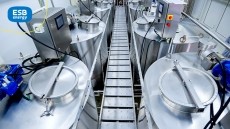Asda tries out green liquid nitrogen fridge in trailer

Asda is planning to replace the traditional diesel-fuelled fridges in its transport fleet with an emission-free, silent running alternative, which, it is claimed, will reduce carbon emissions and noise pollution when delivering to its stores.
The so-called Ecofridge, which is being tested out in seven articulated vehicles at Asda's Skelmersdale depot, will reduce the overall amount of carbon emitted by its fleet by around 860t, helping the supermarket to achieve its commitment to cut carbon emissions by 80,000t by the end of 2008.
If the trial is successful, the fridge - which runs off liquid nitrogen rather than diesel - may be rolled out to its entire fleet of temperature controlled trailers. By switching all of its fleet to this technology, Asda estimates it could reduce carbon emissions by 70,000t over the next five years.
The Ecofridge, designed by Ukram Industries, uses liquid nitrogen as the accelerant in cooling, eliminating the environmentally damaging carbon dioxide and hydrofluorocarbon (HFC) gas emissions with traditional diesel-powered fridges. According to the Department for Transport figures, 2.6kg of carbon are generated for each litre of diesel burned. However, owing to the Ecofridge's engineering simplicity, maintenance costs are also reduced by at least 65%, claims Ukram.
Chris Hall, Asda's network transport manager, says: "This is a major step towards ensuring that our fleet transport reduces costs, cuts carbon emissions and lowers the overall environmental impact of food distribution. It also solves the problem of delivering chilled goods to our stores in residential areas - especially at night, due to the silent running nature of the technology."
Last year all 1,000 of Asda's distribution lorries were converted to run on a bio-diesel mix, reducing carbon tail pipe emissions by 3%.
Asda is also working with Yorkshire Forward and the UK Carbon Trust. A Carbon Club has also been established with 11 of its major suppliers to identify opportunities to improve energy efficiency in its supply chain.
















